Italian Serie A Team of the 2000s
The Serie A in the 2000s was a canvas that saw artistic excellence rub shoulders with an abomination. A span of 10 years saw the Serie A spend time and then fall from the summit of European football. From being the stomping grounds for the best players in the world to a cesspit of corruption, the 2000s was truly an earth-shattering decade for Italian football.
In a decade where the 2006 World Cup triumph and the calciopoli scandal define Italian football, a lot of objectivity has to be lent to the practice of choosing the best XI of this time period.
The first half of the 2000s saw the Serie A at its best, featuring some of the biggest stars in world football competing with each other. An era that culminated with Italy’s fourth FIFA World Cup title in 2006.
Right after that, the calciopoli scandal destroyed the very fabric of the league. Juventus were demoted to the Serie B and were stripped off the 2004-05 and 2005-06 scudetti. AC Milan too had to face a point deduction in the 2005-06 season. Fiorentina and Lazio had to face season-long bans from the Champions League and UEFA Cup respectively and Reggina were fined €100,000 fine along with a €30,000 fine and a two-and-a-half year ban for club president Pasquale Foti.
Criteria
Player performances, statistics and achievements between the 2000-01 and 2009-10 seasons have been considered.
Player performances during this time period are under consideration. This is the Serie A Team of the 2000s, not the best players to have played in the Serie A. As a result, Zinedine Zidane, who only played the 2000-01 Serie A season in this decade before joining Real Madrid, is not in the XI.
The calciopoli does complicate player assessment in this decade but I have made my best efforts not to factor it in. Still, the damage done by the scandal to the 2004-05 and 2005-06 seasons cannot be ignored.
The team is primarily made up of players from the Big Three of Italian football – Juventus, Internazionale and AC Milan, as team accomplishments were also a major factor.
Juventus’ representation obviously comes with question marks but it’s also unfair to not acknowledge some sensational players the club fielded in the decade.
Internazionale dominated proceedings in the latter half of the decade and also became the first Italian club to complete the Champions League treble. Nerrazzurri players had to make the XI.
AC Milan might have won only one scudetto in this decade but were constantly in the fight for the title. Moreover, they reached three Champions League finals between 2004 and 2007, winning two. Standout performers from that team deserve to be in the XI.
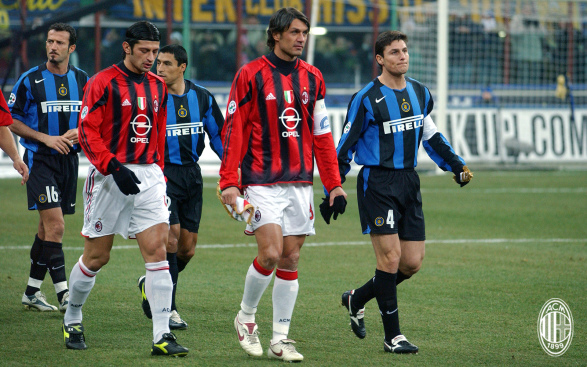
Important note: In the infographics for the players, you will notice a ‘*’ next to the number of Serie A titles won by the player. The ‘*’ denotes that those titles included the 2004-05 and 2005-06 titles won on-field. Due to the calciopoli scandal, Juventus were stripped off the 2004-05 and 2005-06 titles. The former was vacated altogether, and the latter was awarded to Internazionale who had finished second in the 2005-06 season. The Nerazzurri’s official scudetti haul this season is five but they won four on-field.
Goalkeeper
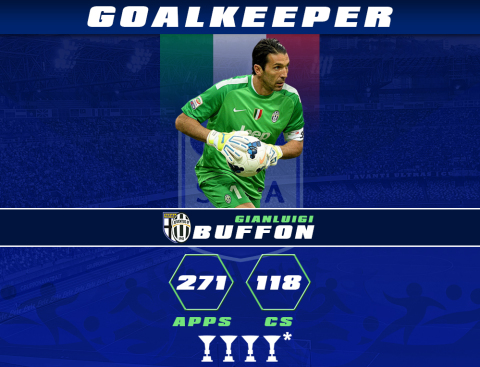
Manning the goal in the Serie A Team of the 2000s is, arguably, the greatest goalkeeper of all time.
Gianluigi Buffon needs no introduction. The Italian shot-stopper is still a part of the Juventus locker-room, albeit in a limited capacity. In the decade that I’m addressing, Gigi solidified his place in the Juventus squad.
After a fruitful spell at Parma, the Italian shot-stopper joined the bianconeri in 2001 in a deal that made him the most expensive goalkeeper in the world at the time. Replacing the departing Edwin van der Sar, Buffon’s impact was instant as his skills at the back helped Juventus to two successive Serie A titles in 2001-02 and 2002-03.
He was also named Serie A Goalkeeper of the Year six times in the decade as well as UEFA Goalkeeper of the Year in 2003 for his effort in leading Juventus to a runners-up place in the 2002-03 Champions League.
During this decade, Buffon was a key member of arguably the best defense in the world that featured the likes of Lillian Thuram, Paolo Montero, Fabio Cannavaro and more.
The trophies aside, Buffon’s biggest contribution to Juventus and Italian football came in the aftermath of the calciopoli scandal. The Italian goalkeeper could have joined teammates like Patrick Vieira and Zlatan Ibrahimovic and left The Old Lady. Instead, he opted to stay at the club and lead them out of the Serie B, cementing his exalted status at the Turin club.
Defenders
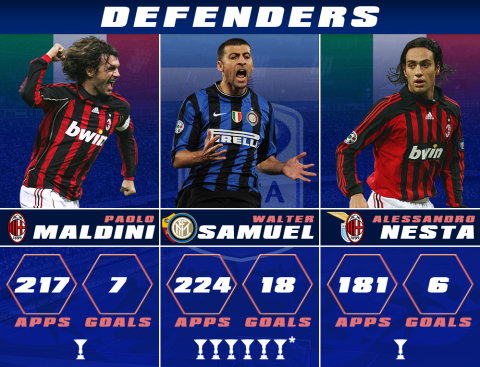
I’m going with a three-man defense for the Serie A Team of the 2000s, featuring a legendary pairing.
AC Milan might have only won one scudetto in this decade but the center-back duo of Paolo Maldini and Alessandro Nesta was at its imperious best.
The Italian pairing served as the backbone for Carlo Ancelloti’s tenure at the San Siro. The team hit its peak between 2002 and 2007, winning eight trophies in the five-year span that included the 2003-04 league title and the 2002-03 and 2006-07 Champions League titles.
Il Capitano Maldini had already solidified his status as one of the finest defenders in football history in the 1990s. In the 2000s, in his 30s, the defensive maestro became the greatest defender of all time. Maldini shifted from left-back to central defense, in accordance with his declining pace and formed an iron pairing with Nesta, who had captained Lazio to a scudetto in the 1999-2000 season.
The Maldini and Nesta combination was the perfect mix of experience and defensive acumen. Their presence at the back made for a miserly Rossoneri defense and an imposing obstacle for opposing teams.
Joining the AC Milan pair is a defender who starred for AS Roma and the black-and-blue part of Milan.
Argentine defender Walter Samuel is regarded as one of the hardest players in football history, and rightly so. Bone-crunching tackles, gargantuan aerial presence and tight marking was the Argentine’s modus operandi, which played a key role for both Roma and Internazionale.
Samuel joined Roma from Boca Juniors in 2000, integrating seamlessly into the Serie A and winning the scudetto in his debut season. He became an indispensable member of the squad for the next four seasons before moving to Real Madrid.
After a forgetful spell with los Blancos, Samuel returned to the Serie A in 2005 becoming a crucial part of the Roberto Mancini/Jose Mourinho Internazionale dynasty that won five* Serie A titles in a row. Samuel formed solid partnerships with fellow South Americans Ivan Cordoba and Lucio as Inter dominated the league and became the first Italian club to complete the Champions League treble (Serie A + Champions League + Coppa Italia) in the 2009-10 season. Samuel capped off the decade by winning the 2010 Serie A Defender of the Year award.
Wingers
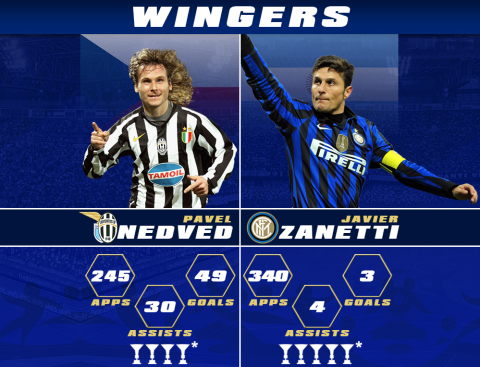
The wingers in this Serie A Team of the 2000s are not your typical attacking players. Instead, I’ve gone for two four-lunged workhorses who could help out on both ends of the field. Both men, in this case, also happen to be talismanic figures for their respective clubs.
“The Czech Cannon” Pavel Nedved mans the left flank, as he did during his nine-year tenure for the bianconeri.
The Czech midfielder was brought in from Lazio as a replacement for Zinedine Zidane, who joined Real Madrid in 2001. Nedved was not only an able replacement, but it can be argued that he eclipsed Zizou in the black-and-white stripes of Juventus.
Strong on either foot, Nedved was a complete midfielder who could shoot, dribble, pass, cross and tackle. His ability to strike from distance as well as long passing and crossing skills made him Juve’s creative outlet. He combined that with his stamina and tactical positioning that enabled him to help out on defense as well.
Playing a starring role in Juventus 2002-03 scudetto win and run-up to the Champions League final, Nedved won the Ballon d’Or in 2003, beating the likes of Thierry Henry and Maldini.
On the right flank, I am going with Internazionale’s inspirational captain, Javier Zanetti.
The Argentine had already established himself as a stellar right-back since his arrival at San Siro in 1995. In the 2000s, el tractor became a more well-rounded player and also shifted to the midfield in order to accommodate Maicon as a right-back.
Zanetti was capable of and played both as a wide midfielder and defensive midfielder. In both spaces, the Argentine’s consistency was on full display. The Argentine’s technique, tactical adeptness and commitment to fitness helped him become a versatile player whose work-rate was a major factor in building Internazionale’s late 2000s dynasty.
Zanetti captained Inter throughout the decade, helping the club win it’s first on-field scudetto since 1988-89 in the 2006-07 season. Three more league titles followed as Inter asserted itself as the dominant force in Italy and Europe by the end of the decade with Zanetti surpassing Giuseppe Bergomi as Inter’s most capped player in history. Unsurprisingly, the Nerazzurri retired the Argentine legend’s number four jersey after his retirement.
Midfielders
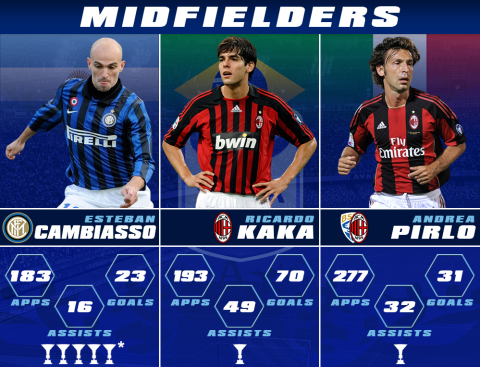
Zeroing in on three midfielders from a bevy of world-class talents was a hard task. Some major names like Daniele De Rossi, Gennaro Gattuso, Clarence Seedorf, Riccardo Montolivo, David Pizzaro, Edgar Davids, Dejan Stankovic and more miss out.
The sheer quality of performances by Andrea Pirlo and Kaka help them walk into the Serie A Team of the 2000s. Both of them were at their peaks during this decade and helped AC Milan to reach three Champions League finals, winning two.
Pirlo, an Internazionale outcast, redefined the regista role under Ancelotti’s tutelage. The Italian was angling to be an attacking midfielder for the Rossoneri but Ancelotti shifted him to a deeper role and Pirlo became the world’s best at his position.
Orchestrating attacks from the deep with his unparalleled vision and passing, Pirlo was helped by having Kaka as an attacking midfielder, alongside prolific forwards in the form of Andriy Shevchenko, Filippo Inzaghi and Alberto Gilardino.
Kaka developed into a devastatingly good attacking midfielder who went on to win the 2007 Ballon d’Or, owing to his chart-topping 10 goals that helped AC Milan win the 2006-07 Champions League. The Brazilian was a perennial fixture in the Serie A assists chart, topping the table in the 2005-06 season. A man who beat Lionel Messi and Cristiano Ronaldo for the Ballon d’Or deserves a place in the Serie A Team of the 2000s.
Joining the Milan duo is Esteban Cambiasso who served as the lung-busting defensive midfielder of the Internazionale dynasty.
Arriving at San Siro in 2004 on a free transfer, he is definitely the steal in this Serie A Team of the 2000s. The Argentine first formed an impressive midfield fulcrum with compatriot Juan Sebastien Veron, with his grit allowing the former Manchester United man to do damage on the offensive front. Cambiasso was also named Internazionale Player of the Year in his debut season for the club.
Over the years, Cambiasso developed into a world-class box-to-box midfielder who was the first name under both Mancini and Mourinho. For anyone who has closely observed the Portuguese manager, Cambiasso was the perfect fit for ‘the special one’s’ tactics. The Argentine spent a decade with the Nerazzurri, winning five scudetti, four Coppa Italia titles, a Champions League and Club World Cup and four Supercoppa Italianas.
Forwards
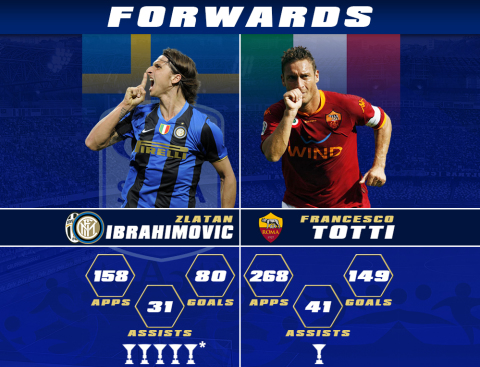
If choosing midfielders was tough, selecting two from an unending list of phenomenal strikers was even tougher. In doing so, I have also made a controversial decision by not putting Alessandro Del Piero. That itself should explain the conundrum.
I’ve gone with Ibrahimovic and Francesco Totti as my front two, with the latter playing a more withdrawn role.
2004 saw Ibrahimovic make his European breakthrough with a much-hyped move to Juventus from Ajax. Benefiting from David Trezeguet’s injury, the Swede was a part of the starting XI as he scored 16 goals in his debut season. The Frenchman’s return next season saw Ibra shunted to the sidelines.
Post calciopoli, the Swede jumped ship to Internazionale and became the goal-scoring machine we all know so well. 15 goals in his first season for the Nerazzurri helped his club win the league title with a record 97 points. He increased his tally 17 goals in the 2007-08 season and then went on to score 25 in the 2008-09 season – a figure that saw him win the capocannoniere award as well as the Serie A Footballer of the Year.
Ibrahimovic’s sensational goal return of 80 goals from 158 games in the decade which helped Inter become a domestic and continental force made me choose him in the Serie A Team of the 2000s.
Rounding up the XI is the Emperor of Rome himself.
Del Piero won more, Trezeguet had more capocannoniere awards and Christian Vieri’s goalscoring rate was much higher. All of them, however, had more resources at their disposal than Totti.
He could have played for Real Madrid or any club of his choice, but he stuck with la Lupa, being the protagonist in the club’s 2000-01 scudetto win – their first since 1982-83.
Functioning as a creative midfielder/second striker in the first half of the decade, Totti’s goalscoring skills reached their peak during Luciano Spaletti’s spell at the Stadio Olimpico.
After winning the 2006 FIFA World Cup, Totti led Roma to its most successful season after 2000-01. Scoring 26 goals in the league, the Roma talisman won the capocannoniere trophy as well as the European Golden Shoe and also topped the league assist charts. He crowned those personal achievements by helping his side to win the Coppa Italia, defeating arch-rivals Internazionale in the final.
His consistent form up front contributed in Roma challenging Inter for the Serie A title in the later part of the decade. I Giallorossi did not knock Il Biscione off their perch but Spalletti and Totti did win a couple of Coppa Italia titles and Supercoppa Italianas. Totti also overtook Amadeo Amadei as Roma's all-time leading goalscorer in this decade.
Il Gladiatore helped AS Roma punch above its weight and attained godlike status in the Italian capital. A deserving pick for the Serie A Team of the 2000s.
The Team
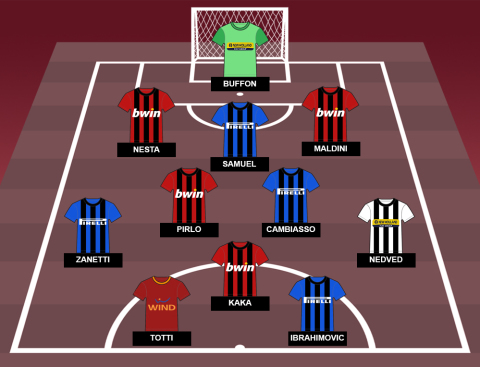
Honorable mentions
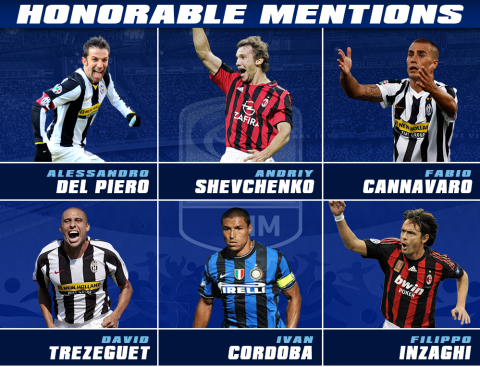
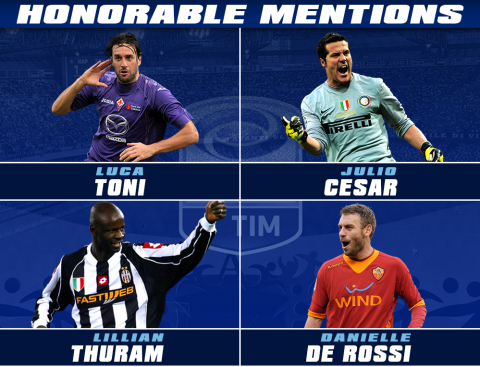


.png)
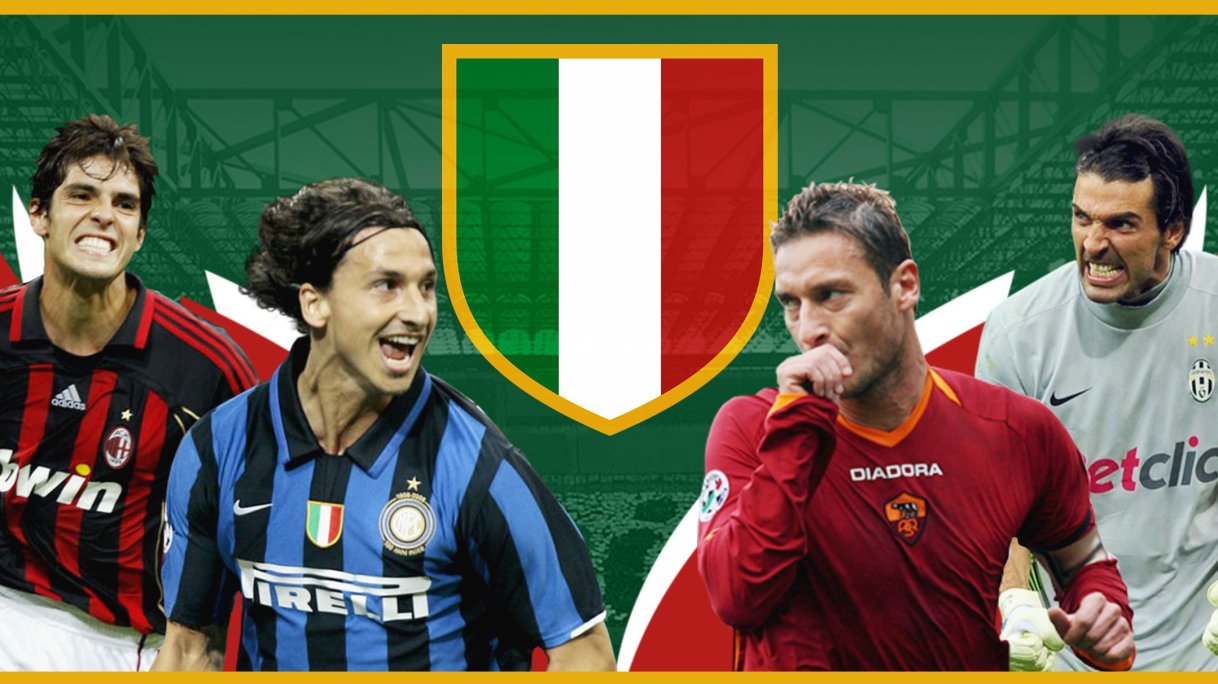

Leave a Reply